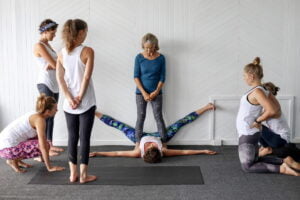
Recently I had the pleasure of assisting international yoga teacher, Donna Farhi, in her Sydney workshop ‘Mastering the Art of Adjustment’. Donna started off by having us think about what our approach to learning is. Do we, for instance, learn by rote or by enquiry? And, what prior learning do we take into new situations that impacts the way we interact with our students.
It’s not often that we take the time to examine how we know what we know and how it influences the way in which we relate to others. This was a slow and methodical beginning to our two days together. But, by the end of the workshop, we had the foundations to make respectful and intelligent adjustments.
I’ve taught many different aspects of yoga, but I do have my favourite subjects. One of these is the art of touch and the adjusting of students in poses.
The point of adjustments, in my view, is to enhance students’ understanding of what they are doing in their practice. To do this well, the yoga teacher needs to grasp that there are three dominant styles of learning. Have a look at these: main styles of learning. One of these is learning through experience or kinaesthetically (the way I learn best). I’ve discovered through my thirty five plus years of teaching that a large number of yoga teachers learn kinaesthetically. Of course, we need to have developed visual and auditory teaching skills, too.
Information conveyed by teachers through the art of touch can be immediate and effective . It’s because the skin is the largest organ in your body. We have almost a million sensory receptors in our skin that communicate with the central nervous system. Without even having to think about it, we get constant information about temperature, pressure and discomfort.
So teachers need to learn sensitivity of touch. As well as the ability to centre, to have clear intentions and to attune to breathing. The more opportunities for trainees and teachers to practice adjusting in and out of workshops, the better.
I will be offering a one-day workshop in Sydney Saturday November 24 at The Yoga Nook. If you think you might be interested in attending, you can contact Linda Apps: linda@yoganook.com.au or leave a message 95509155.
I should mention that a few years ago I wrote a book called ‘The Art of Adjustment’. I created this manual mainly to help trainees improve their understanding of adjusting. It seems that this is a topic that isn’t always addressed in yoga teacher trainings.
What’s special about the way we produced the book is that you can down-load it straight onto your computer. You get text and photographs, as well as, audio (my voice). There are 38 fundamental yoga adjustments described in the book. And, the reader/listener gets a practical and basic insight into just what sensitivity of touch is.
The ‘Art of Adjustment’ is available at the Live Yoga Life website.

Dear Eve, there could be no-one better to learn the art form of the yoga adjustment than you good friend … Lucky will be those who decide to learn this from you. Love, Peter
I’ve noticed a couple of new yoga teachers, as part of their advertising, use non-touch and non-adjustment as a selling point. It’s so sad that inappropriate (OK sleezy) practices by some “yoga” teachers has led to this. Of course we suggest with our words, and ask if our students might explore a happier pose, and we always seek permission, but sometimes that mindful respectful touch says it all. Some of my students report a feeling of security and confidence in the pose as they are guided with hands. Touch in a safe space is also so important for the more senior students whose hearing and sight are not 100%. Add to that that many seniors live alone and miss the human touch. Warm friendly touch means a lot to us all.
So well put, Sue. In Donna’s workshop, we were paced so slowly in learning ‘the art of adjustment’. This meant that there was plenty of time over the two days to also develop trust, to create a safe space with each other.
It’s true that many people who live alone and/or are older are touch-starved. Of course it needs to be respectful and appropriate touch, free from any agenda. Which is the ideal way for us as teachers to offer adjustments to our students.